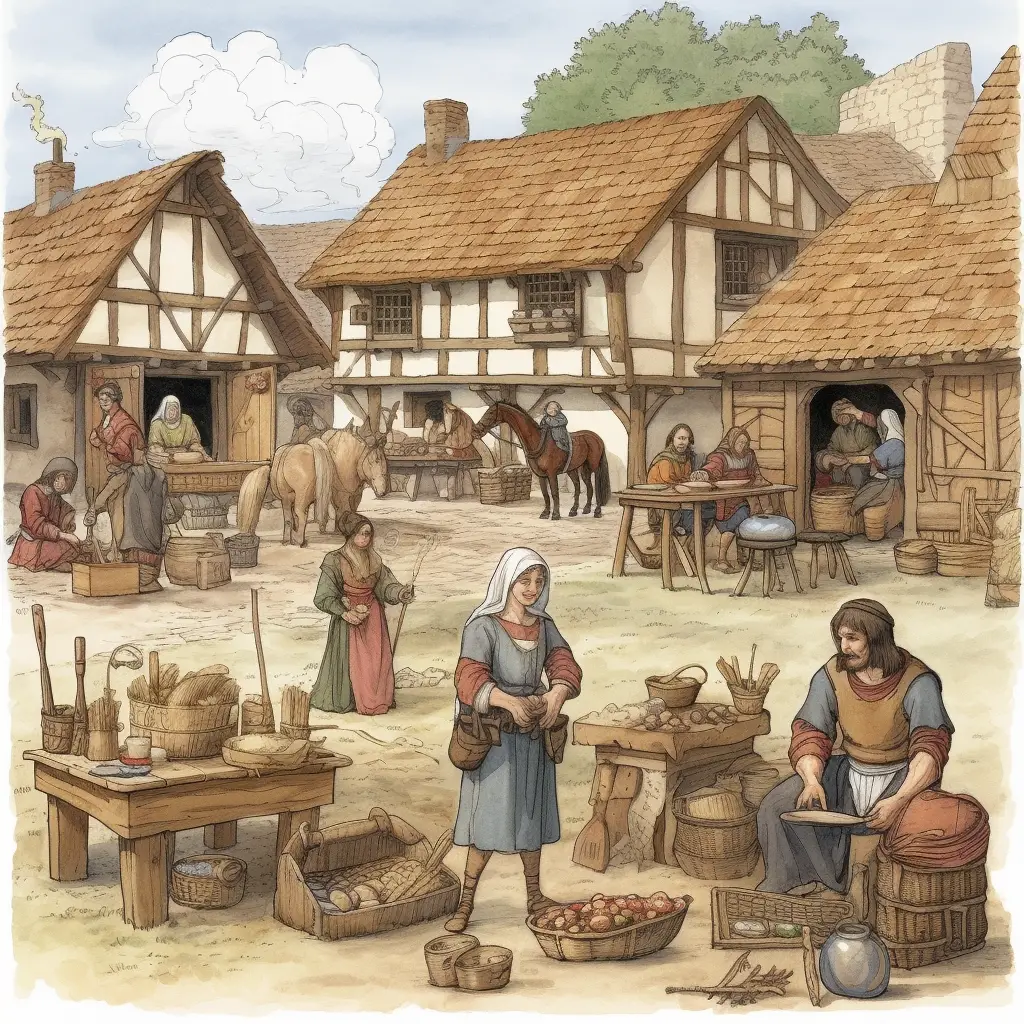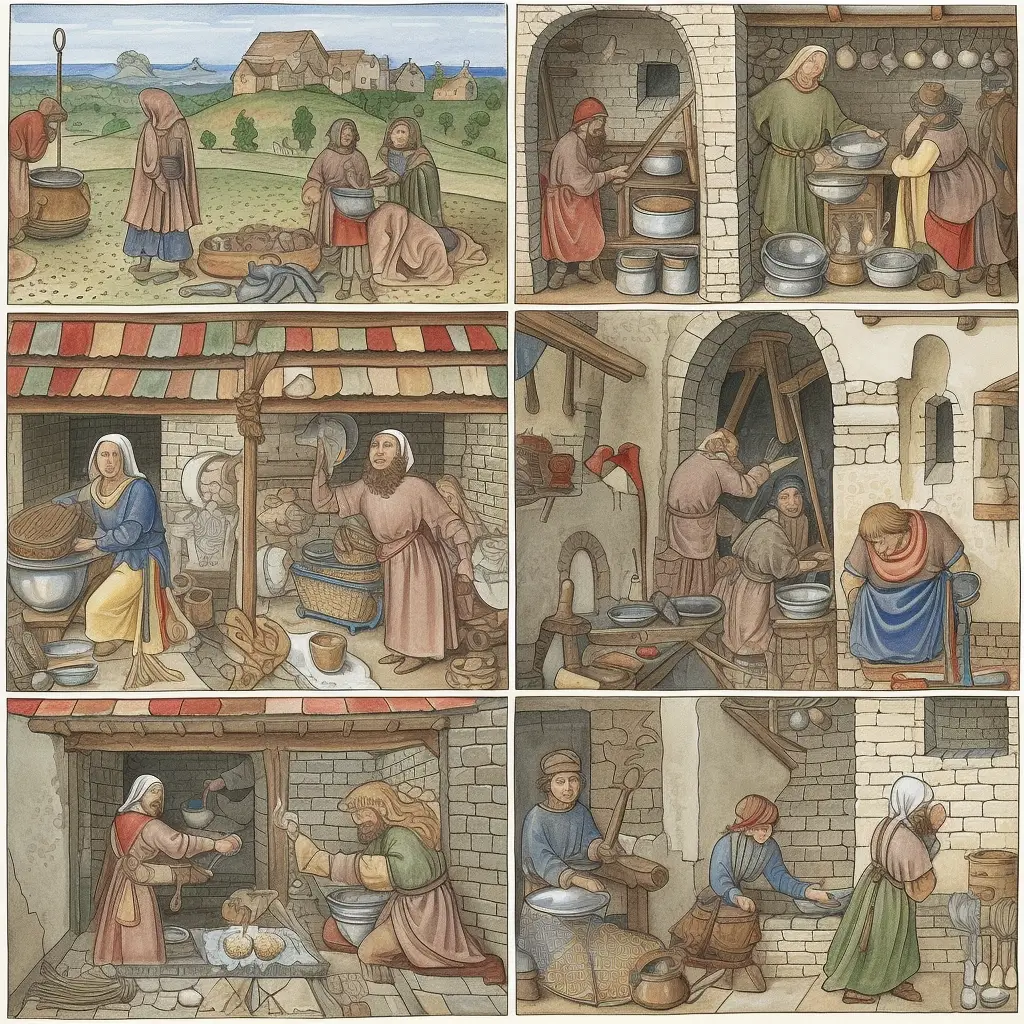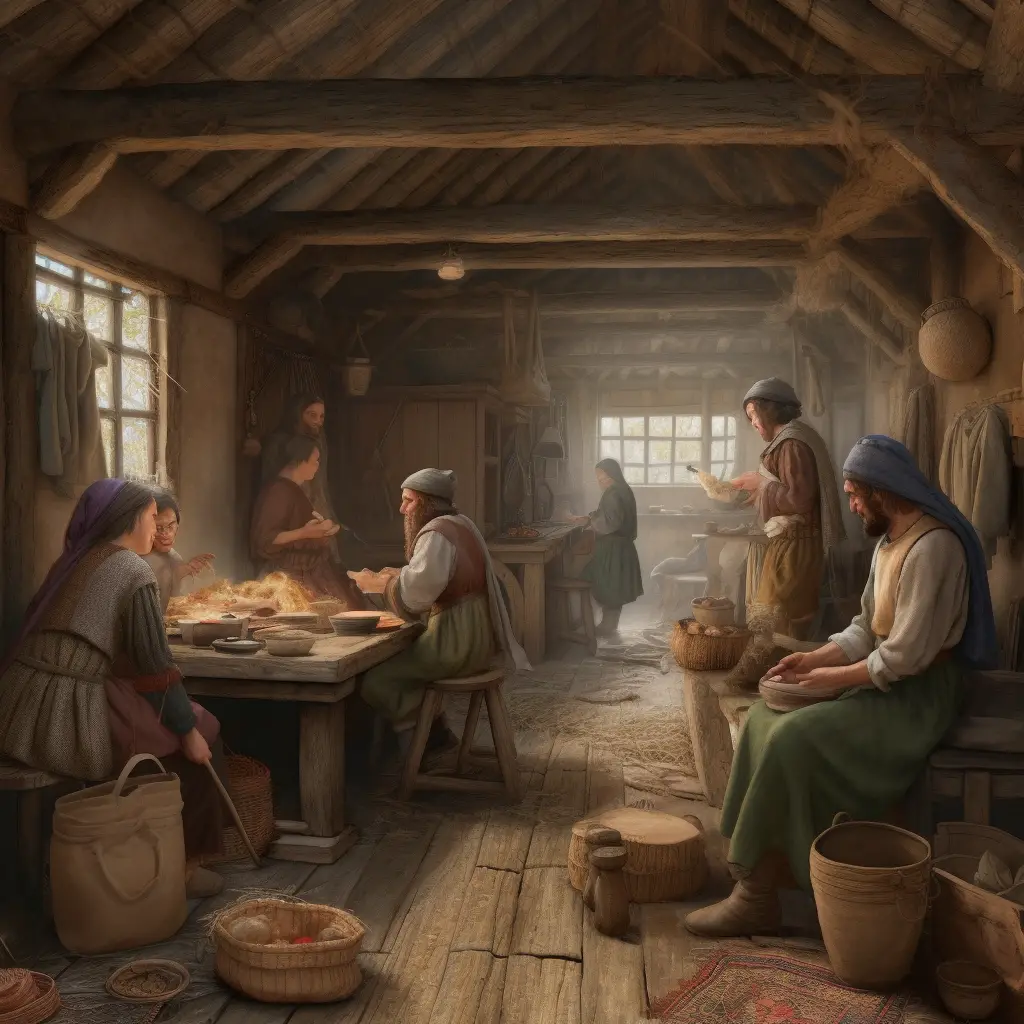Medieval Daily Life
Medieval daily life was centered around agriculture and religion. Most people lived in small villages and worked as farmers, growing crops and raising livestock. The church played a significant role in daily life, providing spiritual guidance and social support.
Life was often difficult, with limited access to healthcare and education, and frequent outbreaks of disease and famine. Despite these challenges, medieval society laid the foundation for many of the cultural and social norms that still exist today.

Medieval Daily Life Facts for Kids
- Most people in medieval times were farmers.
- They ate lots of bread, cheese, and soup.
- Only rich people could afford spices.
- Many children worked instead of going to school.
- Homes were often one room, with straw beds.
- Toys were homemade, like dolls or wooden swords.
- Medieval people wore woolen or linen clothes.
- People usually married in their early teens.
- They had no toothbrushes, so their teeth were often bad.
- Knights practiced games like jousting.
Feudal System
Feudalism defined medieval life. The monarch, nobility, knights, clergy, and peasants composed society. The monarch gifted lands, or ‘fiefs’, to loyal nobles. These nobles granted parts of their lands to knights who swore to protect them. Peasants formed the majority, laboring from dawn to dusk to cultivate these lands. Despite forming society’s backbone, their rights were minimal, living and working on the same land.
Medieval Agriculture
Most medieval people were peasants, their days defined by agriculture. Their work was seasonal: planting in spring, growing in summer, harvesting in autumn, and preparing in winter. They cultivated crops like wheat and vegetables, and reared livestock. However, despite their labor, their diets were basic, as much of the produce was paid as taxes.
Medieval Clothing
Medieval clothing indicated status and occupation. Peasants wore simple woolen or linen tunics in dull colors, men added breeches, and women wore long dresses. In contrast, nobles displayed wealth with fine fabrics like silk, and embroidered designs. Footwear was simple leather, and hats denoted wealth.
Middle Ages Food & Diet
Medieval diets varied by status and season. Peasants mainly ate bread, cheese, vegetables, and ale, with meat a luxury. Bread was from barley or rye, and vegetables were seasonal. Nobles, however, had a richer diet with meat, fish, fruits, spices, and wine. Church-led fast days also shaped dietary habits.
Medieval Trades & Crafts
Medieval daily life involved essential trades and crafts. Roles like blacksmiths, weavers, bakers, and carpenters were common. Skills were passed down through generations. Craftsmen formed guilds for standards, training, and protection. Their goods, like tools, cloth, food, and furniture, were community essentials.
Chivalry & Knighthood
Knighthood and chivalry shaped medieval life among the nobility. Knights, loyal warriors serving lords, upheld a code of chivalry emphasizing bravery, loyalty, and honor. The journey to knighthood started young, progressing from page to squire, then a knight. Knighthood wasn’t just about battle, but also moral values.
Medieval Religion & Church Influence
Religion pervaded medieval life, with the Church influencing society. People were devout Christians, their lives intertwined with church services. The Church set moral standards, controlled education, and influenced politics. The calendar revolved around religious events.
Medieval Medicine & Health

Medieval life was shaped by primitive medical practices. Illnesses were thought to arise from imbalances of the four humors. Treatments included herbs, prayers, and bloodletting. Poor sanitation led to disease outbreaks. Monasteries served as health centers, setting the foundations for modern medicine.
Castle Life in the Middle Ages
Medieval Castle life, reserved for nobility and retainers, was a mix of privilege and hardship. Castles sheltered the lord’s family, servants, soldiers, and craftsmen. Days were busy with battle training, estate management, hunting, feasting, and tournaments. Despite the cold, damp interiors and lack of privacy, castles symbolized power and status.
Education in the Medieval Period
Medieval education was mostly for the clergy and nobility, taught in monasteries, cathedrals, and universities. The curriculum included Latin, theology, law, and medicine. Home tutoring was available for the wealthy. However, most peasants were illiterate. Still, the period saw the rise of early universities.
Medieval Europe
Medieval European life revolved around social hierarchy, religion, and labor. Peasants worked hard on noble-owned lands. Nobility and clergy focused on governance, prayer, study, or military duties. The Church guided moral conduct and marked time. Communal events brought life vibrancy.
Medieval England
Medieval England’s daily life was shaped by feudalism. Peasants farmed, herded, and practiced crafts. Villages fostered community bonds and seasonal work. The Church provided guidance and organized festivities. Towns facilitated trade and governance. Despite challenges, medieval England thrived with its social order and cultural traditions.
Pressures and Privileges of Noble Life
During the Early Middle Ages (550-1000), nobles lived more comfortable lives than the lower classes (peasants), but this did not mean that they were always easier. Nobles had a lot to think about: governing their lands, keeping the loyalty of their workers, and staying in favor with the king. Remember learning about everyone answering to someone else during the period of feudalism? That put quite a lot of pressure on a noble to make sure that his vassals were loyal to him. Of course, it also meant that a lord had the finest house (aside from his king) and ate foods that the peasant class could not afford—especially meat, and lots of it.
The Duties and Challenges of Serfs in the Early Middle Ages
Serfs, the term for the lower classes during the Early Middle Ages, were very busy people, but in different ways. Rather than looking over other people and keeping order, they spent their time planting crops and making clothing for the manor (and everyone who lived there). Keep in mind that making clothing or any sort of cloth was a big chore at this point in history. Yarn had to be spun, and a steady hand for needlework was necessary not only to make designs on clothing, but to make clothing itself.
Monastic Life and Knightly Training in the Middle Ages
Monks lived inside monasteries, where (unless invaded) they were safe and had food to eat, though their lives were devoted to religion and education, and they spent long hours reading and writing texts—the same texts to which we owe a lot of our knowledge of the Middle Ages. Meanwhile, if a boy wanted to become a knight, he very often had to be of noble birth (born into a noble family), and spend years in training, during which he was given more and more responsibility. Noble boys would begin their training as early as age seven. Can you imagine becoming a page so young?
Leisure and Entertainment in the Medieval Period
Aside from all of this training and work, the nobles and peasants were still allowed to have fun. No television and video games, obviously, but there were still some things that people of the medieval period did for fun that we continue to enjoy today. We might not have wandering minstrels to sing to us, but we still enjoy music. We can check our computers for the latest news, but we still enjoy listening to stories being told aloud about many different topics, and obviously, we still like to dance and play games. People of the medieval period enjoyed these things too, and often watched plays to learn about what was going on in the world or to hear stories and legends being passed around.
Education and Career Paths in the High Middle Ages
During the High Middle Ages (1000-1300), education became more widespread, but still, it was far more likely for a male to go to a university to learn than a female, although girls of the noble class were still often taught to be ladies of the household, which meant they learned needlework and account keeping. If they became nuns, reading and writing were also taught. Overall, young noble boys had a lot going on around them during the High Middle Ages. They might feel driven to fight in the Crusades, they might decide to attend universities, train to become priests, or decide to learn a craft and become an apprentice to a guild master. There, they would spend many years learning a profession (or skill), until finally, they gained master craftsman status.
Life and Exploration in the Late Middle Ages
The Late Middle Ages (1300-1500) saw great losses of life, and so the daily life of anyone living during this period might have been focused on trying to eat as well as possible and avoid catching the plague. On the other hand, toward the end of the Late Middle Ages, after The Great Famine and The Black Death, advances in technology, art, and culture meant that a new world was open to the people.
Adventurers wishing to live the life of a crew member of a ship could sail to discover new lands, trade with new places meant more interesting spices for food and items never seen before, and education was even more important in a world filling with tales, poems, stories, and news from far-away places.
City life could be cramped, but it was filled with many different types of people, each with their own hopes and abilities. The people of the medieval period may have spoken different languages than us (from Old English and French and Latin to Middle English), but at heart, they still wanted what we do: a good dinner, a warm place to sleep, an education, and from time to time, fun and games.
What was the daily routine of a peasant in the Middle Ages?
Peasants in the Middle Ages had a daily routine that revolved around their work. They woke up early in the morning to tend to their crops and animals, and spent most of their day working in the fields. In the evenings, they would return home to tend to their families and prepare for the next day’s work. Life was hard for peasants, but their daily routine was essential to their survival.
What were the different types of jobs that people had in medieval towns?
In medieval towns, people had a variety of jobs such as blacksmiths, bakers, weavers, and carpenters. There were also merchants, traders, and bankers who conducted business in the town. Some people worked in the church as priests or nuns, while others were involved in the administration of the town as officials or judges. The jobs available varied depending on the size and wealth of the town.
What was the role of the church in medieval society?
The church played a significant role in medieval society as it was the center of religious and social life. It provided spiritual guidance, education, and healthcare to the people. The church also had significant political power and influence, often working closely with monarchs and nobles to maintain order and control. However, the church’s power was not without criticism, as corruption and abuse of power were prevalent during this time.
What were some of the challenges that people faced in medieval life?
Medieval life was marked by numerous challenges, including disease outbreaks, famine, and war. The lack of advanced medical knowledge and sanitation practices made it difficult to contain and treat illnesses. Crop failures and food shortages were common, leading to widespread hunger and malnutrition. Additionally, constant warfare and political instability created a sense of uncertainty and danger for many people.

What were some of the pleasures of medieval life?
Medieval life offered simple pleasures such as communal feasts, music and dance, and storytelling. Festivals and fairs were also popular, providing opportunities for socializing and entertainment. Sports and games were enjoyed by both adults and children, including archery, wrestling, and board games. However, life was also difficult with limited access to healthcare and education, and the constant threat of disease and war.
How did the Black Death affect medieval society?
The Black Death, a devastating pandemic that swept through Europe in the 14th century, had a profound impact on medieval society. It caused a significant decline in population, leading to labor shortages and economic disruption.
The social structure was also affected, with the loss of many skilled workers and the breakdown of feudalism. The pandemic also had cultural and religious implications, with many people turning to extreme forms of piety and others questioning the role of God in such a catastrophic event.
What were some of the major technological innovations of the Middle Ages?
During the Middle Ages, several technological innovations emerged, including the invention of the printing press, the development of the mechanical clock, and the creation of eyeglasses. These advancements revolutionized communication, timekeeping, and vision correction, respectively. They also paved the way for further technological progress in the centuries that followed.
How did the Renaissance influence medieval society?
The Renaissance had a significant impact on medieval society. It marked a period of cultural and intellectual rebirth that brought about new ideas and advancements in art, science, and philosophy.
The Renaissance challenged traditional beliefs and values, leading to a shift towards humanism and individualism. This movement paved the way for the scientific revolution and the Enlightenment, ultimately shaping the modern world as we know it today.
What were some of the lasting legacies of the Middle Ages?
The Middle Ages left a lasting impact on Western civilization. The period saw the rise of feudalism, the development of Gothic architecture, and the spread of Christianity. The legacy of the Middle Ages can also be seen in modern political systems, literature, and art. The period’s influence can still be felt today, making it a crucial era in the history of the world.
What were the most common forms of entertainment in the Middle Ages?
During the Middle Ages, common forms of entertainment included storytelling, music, dancing, and games such as chess and backgammon. Jousting tournaments and theatrical performances were also popular among the upper classes. Additionally, religious festivals and fairs provided opportunities for communal celebration and entertainment.
What were some of the most popular foods and drinks in the Middle Ages?
During the Middle Ages, the most popular foods were bread, porridge, and stew, while the wealthy also enjoyed meat, fish, and wine. Beer and ale were the most commonly consumed drinks, as they were safer to drink than water. Spices such as cinnamon, nutmeg, and ginger were also highly valued and used to flavor food and drink.
What were some of the most popular clothing styles in the Middle Ages?
During the Middle Ages, clothing styles varied depending on social class and region. Commoners typically wore simple garments made from wool or linen, while nobles donned more elaborate attire made from silk, velvet, and fur. Women’s fashion included long dresses with fitted bodices and flowing sleeves, while men’s fashion featured tunics, hose, and cloaks. Accessories such as hats, belts, and jewelry were also popular among both genders.
How did people travel in the Middle Ages?
People in the Middle Ages traveled primarily by foot, horseback, or by using carts and wagons pulled by animals. Wealthier individuals could afford to travel by boat or by using carriages, but these modes of transportation were not accessible to the majority of people. The lack of efficient transportation made long-distance travel difficult and dangerous, and it was often reserved for important missions such as trade or military expeditions.
What were some of the most important events in medieval history?
The medieval period was marked by significant events that shaped the course of history. These include the fall of the Roman Empire, the rise of Christianity, the Crusades, the Black Death, the Hundred Years’ War, and the Renaissance. These events had lasting impacts on politics, religion, culture, and society, and continue to influence our world today.
What were some of the most famous people from the Middle Ages?
The Middle Ages were a time of great historical figures, including Joan of Arc, William the Conqueror, Charlemagne, and King Richard the Lionheart. These individuals left a lasting impact on history through their military conquests, political maneuverings, and cultural contributions. Their legacies continue to be studied and celebrated today, providing insight into the complex and fascinating world of the Middle Ages.
What are some of the most popular myths and legends from the Middle Ages?
During the Middle Ages, many myths and legends were created and passed down through generations. Some of the most popular include the legend of King Arthur and the Knights of the Round Table, the myth of Robin Hood and his band of Merry Men, and the tale of Beowulf and his battle against the monster Grendel. These stories continue to capture the imagination of people today and have influenced literature and culture for centuries.
What are some of the most important contributions of the Middle Ages to modern society?
The Middle Ages contributed to modern society in numerous ways, including the development of modern universities, the creation of the printing press, and the establishment of modern legal systems. These advancements laid the foundation for modern education, communication, and justice systems, and continue to shape our world today.
What are some of the most common misconceptions about the Middle Ages?
Many people believe that the Middle Ages were a time of darkness, ignorance, and brutality. However, this is a misconception. The Middle Ages were a time of great cultural, scientific, and artistic achievements, and many of the foundations of modern Western civilization were laid during this period.



